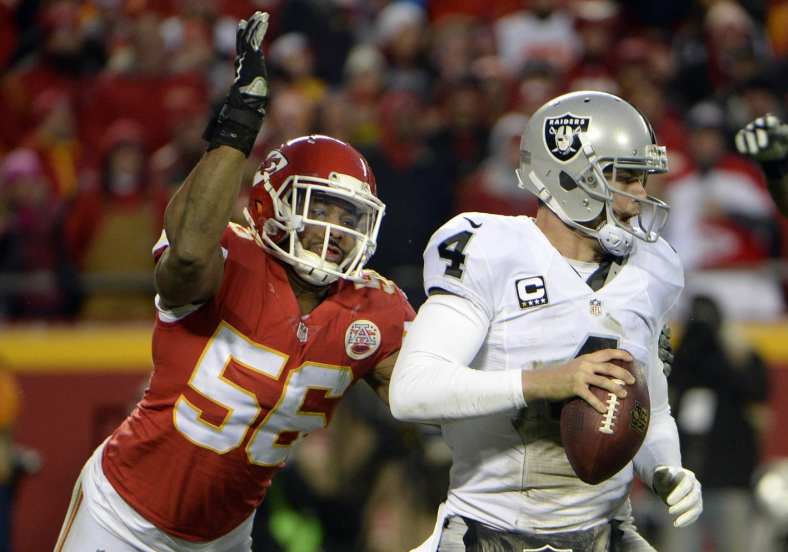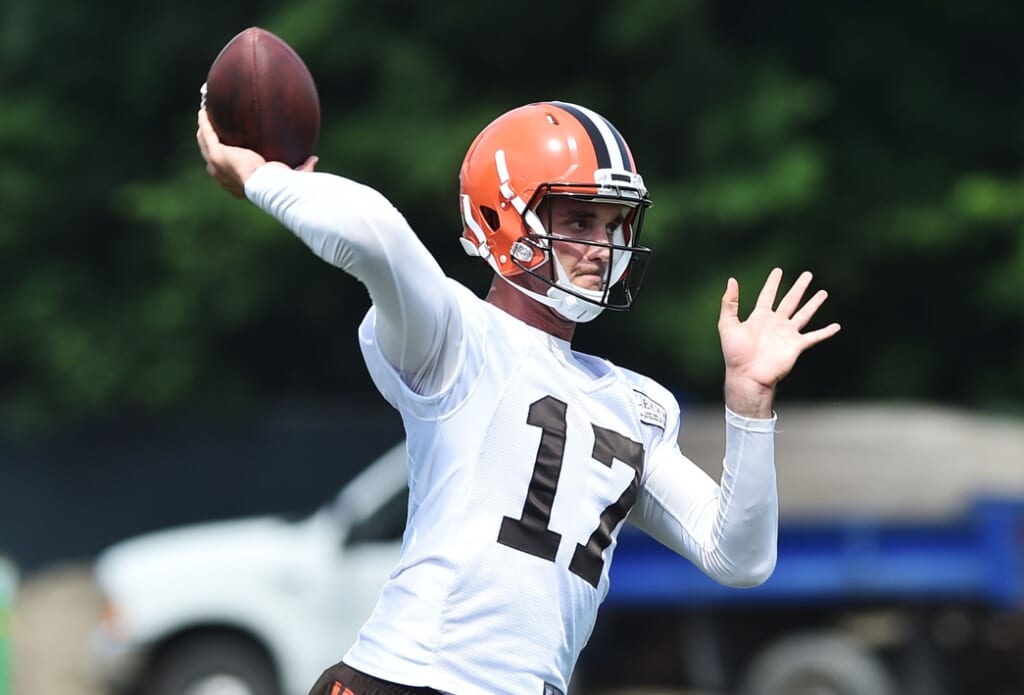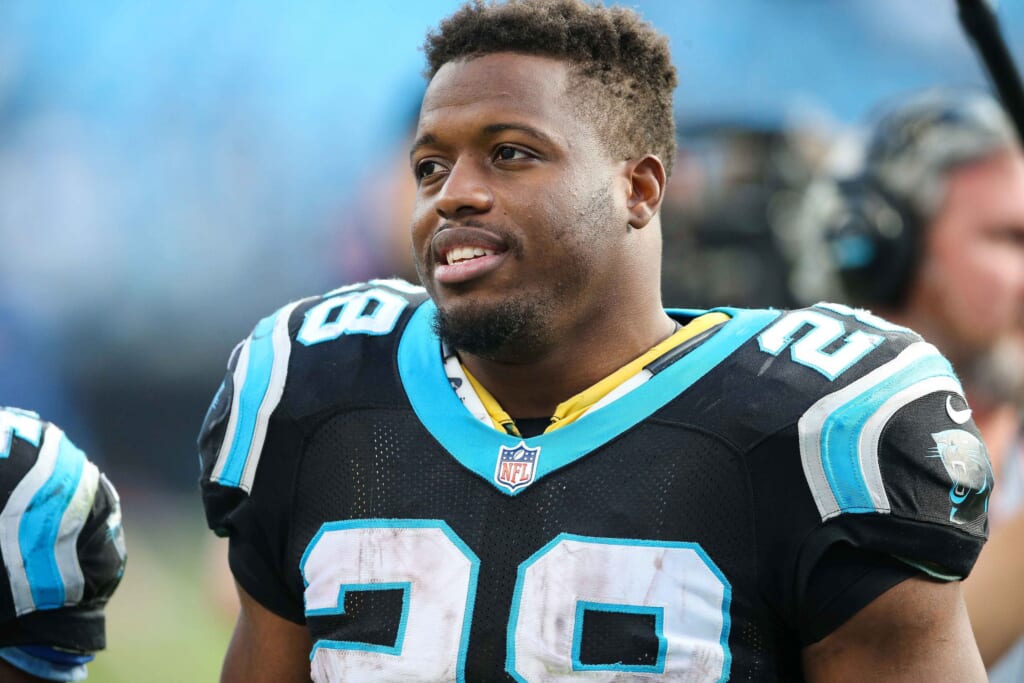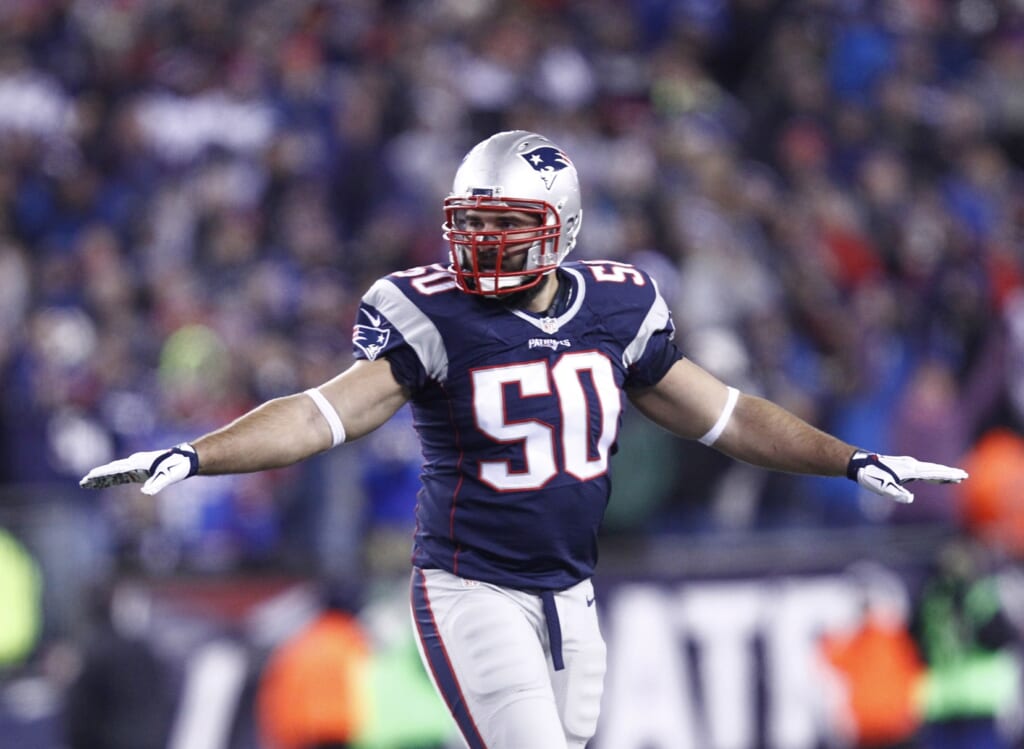
With NFL training camp on the horizon, football season is finally in sight. The months-long trek to Minneapolis — the site of Super Bowl LII — is about to begin. Soon, it’ll be time for Hard Knocks, the Hall of Fame Game, mock fantasy drafts and unfounded preseason hype.
Training camp is where some unknown players get their starts. But it’s also where many careers meet their end. For every undrafted free agent whose dreams come true, a stalwart veteran loses his job. There are quarterbacks whose performances relegate them to the bench and franchise legends who get cut. Players have a lot to lose.
This list examines 10 players who come into camp with jobs on the line. Some are staring at time on the bench, but others could see their careers end if they don’t perform. The NFL is a ruthless business.
Christian Hackenberg, quarterback, New York Jets
NFL scout 'taken aback' by horrible Christian Hackenberg pregame tape from last year https://t.co/rAE4cmatFt #Jets Unless Christian … pic.twitter.com/bP44tGoZcL
— Sportsnaut (@Sportsnaut) May 21, 2017
It’s rare that a second-round pick gets cut in his second season before ever playing, or even making the active roster on gameday. But the Jets have a talent for the unique. Despite a truly horrific quarterback situation — Hackenberg, Josh McCown and Bryce Petty will be duking it out for the job — Hackenberg is already in third place out of three.
During minicamp, Hackenberg’s accuracy was so bad that he hit reporters standing on the sideline. It doesn’t reflect well on the Penn State product that he wasn’t good enough to be on the active roster last season, even as the Jets looked high and low for a solution at quarterback.
Head coach Todd Bowles may not cut Hackenberg this year. It would be an embarrassing mark on GM Mike Maccagnan’s record, and one has to imagine the organization sees something in him. After all, it did spend a second-round pick on Hackenberg for some reason.
But failing to land the starting job this year, when the alternatives are McCown (a 38-year old with no discernible upside) and Petty (who already tried and failed to impress under center last season) is nearly as bad. If nothing else, it would be another indicator that the Jets threw away a second rounder, and that Hackenberg will never be good enough to play in the NFL.
Brock Osweiler, quarterback, Cleveland Browns
At this point, it’s clear what will happen to Osweiler over the next year. Whether he wins the starting job over Notre Dame product DeShone Kizer or not, there’s no monetary incentive for the Browns to cut him this season. It would only create $16 million in dead cap space, per Spotrac. Unless Osweiler magically transforms into the second coming of Bernie Kosar, however, Cleveland will almost certainly get rid of him after this season when his contract has an out that allows the Browns to cut him without losing a dime.

In that sense, Osweiler doesn’t have much to lose. However, if he wants a job after this season, this is the most important month of his career.
If Osweiler fails to win the job and becomes the backup on the worst team in football, doomed to be cut after the season, it’s tough to see many teams paying him when free agency comes, even for a backup job. However, if he can keep the job (and play respectably), Osweiler could easily land a backup job for the 2018 season. Maybe he could even be a starter on certain teams. It’s a slim possibility after he blew his chance with the Houston Texans last season. But if there’s a chance of Osweiler remaining a starter in the league, he has to crush it in training camp.
Mike Glennon, quarterback, Chicago Bears
Glennon experienced one of the all-time bad breaks when the Bears traded up to draft UNC quarterback Mitch Trubisky mere weeks after Glennon signed a three-year, $45 million deal with $18.5 in guaranteed money to (he thought) be Chicago’s starter. The party line is that the former Bucs backup will start the year under center, but a bad training camp could change that.
Given that Chicago is a demonstrably bad football team staring at another last place finish in the NFC North, there’s no doubt the season will be marked by calls to start Trubisky because it’s better to get him some experience than run out the clock with Glennon. Barring a miracle run by Glennon, those calls will probably start around the midway point of the season, but if Glennon plays badly in training camp (and the preseason) they could start before the end of the preseason.
This would be disastrous for Glennon because at some point, the Bears are going to look at this situation and realize that there is nothing to lose by playing Trubisky, even if Trubisky is terrible, which he might well be. Glennon may have gotten paid, but the Bears can still release him after this year with minimal cap damage. Whether he plays will have a big impact in what his market looks like next winter if the team does release him. Starting even just eight games will make a big difference given that Glennon has thrown only 11 passes since the 2014 season.
Andre Ellington, running back, Arizona Cardinals
There’s no suspenseful training camp battle looming for Arizona’s starting running back position. David Johnson has a chokehold on it, both for this season and the foreseeable future. However, Ellington could be fighting for a job nonetheless.
Ellington simply hasn’t been a factor over the past two seasons. That’s not entirely his fault — he’s dealt with injuries — but the NFL is a business that looks solely at the bottom line. And 79 rushing attempts in two years isn’t worth holding a roster spot for if Ellington doesn’t crush it in training camp.
To add onto the pressure, the Cardinals also drafted running back T.J. Logan, a UNC product, in the fifth round. As someone who can catch passes and pass block solidly in addition to running, Logan’s versatility makes him a strong fit for a backup role. In other words, Ellington could be toast.
Jonathan Stewart, running back, Carolina Panthers

The Panthers made finding Stewart’s replacement their top priority in the draft, taking Christian McCaffrey eighth overall. That doesn’t bode well for Stewart on its own, but there are a myriad of other factors that could lead to him being cut, Stewart’s contract being the biggest.
Though it’s not a monster deal like Doug Martin’s (more on that in a bit), cutting Stewart would net Carolina a little over $3 million in cap savings, per Spotrac. It would create some dead money as well — significantly more than if Carolina waited until next season — but if the Panthers think there’s an in-house replacement, there’s fiscal justification.
Fozzy Whittaker and Cameron Artis-Payne won’t be getting Pro Bowl nods anytime soon, but Whittaker was solid in a limited role last season. As for Artis-Payne, the Panthers have to either start putting him on the active roster come gamedays or concede that they wasted a fifth-round pick back in 2015.
Then there’s the matter of Stewart’s own performance last season: a mere 3.8 yards per carry, ranking 35th among running backs in efficiency, as measured via DVOA, and a 44 percent success rate. He also hits age 30 this season, a benchmark when running backs traditionally decline.
Add all of that up and Stewart’s position doesn’t look that safe.
Doug Martin, running back, Tampa Bay Buccaneers
Martin may be the most endangered player on this list of endangered players, at least when it comes to a potential training camp cut. After his All-Pro 2015 campaign, the running back signed a five-year, $35 million deal with $15 million in guaranteed money.
But that was before last season, when Martin’s durability became an issue again and he played just eight games. That was before Martin, in those eight games, rushed for a pathetic 2.9 yards per carry. That was before Jacquizz Rodgers rushed for 560 yards in five starts in Martin’s absence. That was before Martin was suspended three games for using PEDs.
Make no mistake, Martin is facing an uphill battle. His contract allows for the Bucs to release him without a cent of dead money, according to Spotrac, which means there are no negative fiscal implications of a release. It’s far from a sure thing that Rodgers is the same player, but training camp will determine which way the Bucs go here. Right now, Martin is the underdog.
Danny Amendola, wide receiver, New England Patriots
Danny Amendola takes huge paycut to return to Patriots https://t.co/hIfDfBTQMb #NewEnglandPatriots With the addition of Brandin Cooks, … pic.twitter.com/E1tHwE1UoS
— Sportsnaut (@Sportsnaut) April 18, 2017
After acquiring Brandin Cooks in the offseason, the Patriots have truly insane depth at wide receiver. Between Cooks, Julian Edelman, Chris Hogan, and Malcolm Mitchell — not to mention what Rob Gronkowski does as a pass catcher — Amendola is pretty far down on the depth chart.
The 31-year old had only 29 targets last season. He was expendable before the Patriots added Cooks. Now that they have, it’s hard to see his path to a roster spot. There would be some dead money if the Pats released Amendola, but they’d save a nearly equal amount and his base salary is only $1.25 million anyway.
Andrew Hawkins, who signed a one-year deal, can be New England’s injury insurance. If they need a sixth receiver, Matthew Slater could fill the role in an emergency. Unless Amendola impresses in training camp, it’s very easy to see a future for the Patriots without him.
Jermaine Kearse, wide receiver, Seattle Seahawks
As things stand, Kearse comes into camp fighting for his job. A look at Seattle’s wide receiver depth chart reveals that, without a doubt, Doug Baldwin and Tyler Lockett (health pending) are ahead of him on the depth chart. At the No. 3 receiver spot, Paul Richardson is two years younger, makes less money, and despite worse numbers by counting stats last season, crushed Kearse in PFF grading by over 30 points. Seattle also spent a third-round pick on former Michigan wideout Amara Darboh. Oh, and Tanner McEvoy is a sure bet to get some snaps heading into his second season.
Like Amendola, Kearse may simply get squeezed out by the depth chart. It doesn’t help that he struggled last season either, putting up an abysmal 46-percent catch rate and 44.2 PFF grade on only 510 receiving yards.
Cutting Kearse would create roughly $1.8 million in dead cap, per Spotrac, but there may not be a better option unless Lockett’s condition worsens (as of now, it seems likely he’ll play the season opener). Seattle isn’t going to pay $2.2 million for someone who could be sixth in their depth chart. It just isn’t logical. Without a strong training camp that proves he can be more than that, Kearse’s time in Seattle could be coming to an end.
Rob Ninkovich, defensive end, New England Patriots

Ninkovich has seen a steady decline in production since hitting age 30 and he’s now 33. He had just 4.0 sacks last season and a 51.0 PFF grade, and we all know that Bill Belichick hates paying for veterans who have outlived their production, though cutting Ninkovich would only net $1.75 million in cap savings, per Spotrac.
Perhaps more importantly, New England has replacements waiting in the wings. It brought in Kony Ealy and Lawrence Guy this offseason and drafted Youngstown State edge rusher Derek Rivers in the third round — the team’s first pick in the draft. Ealy’s track record is mixed, but there’s a viable rotation there. Guy makes sense as a two-down player and Rivers could rotate in on third until his run defense skills are more developed. That leaves out Ealy, who has potentially the highest upside of the three (in the very short term), but the Patriots can find snaps if he earns them.
Ninkovich will have a chance to earn his snaps as well, come training camp. If Belichick thinks he has something left in the tank, New England will probably decide to keep a player who has been with the team since 2009. However, Ninkovich is expendable, aging and declining — a lethal combination this time of year.
Derrick Johnson, linebacker, Kansas City Chiefs
Every training camp, there are some names on the last round of cuts that nobody sees coming. This year, one of them very well could be Derrick Johnson.
Right now, it’s a question as to how much Johnson will even participate in training camp, as he’s still recovering from the Achilles tear that ended his 2016 season early. However, that injury is (unfortunately) at the top of the list of reasons he could be cut. It isn’t his first major injury, and at the age of 34 Johnson’s durability isn’t particularly good.
There are also potentially large cap ramifications for next year. If the Chiefs cut him now, Johnson’s $10.25 million cap hit next season becomes $2.25 million in dead money. Given that Kansas City seems to be tacking in a rebuilding direction after drafting Patrick Mahomes, the franchise probably doesn’t want that type of money on their books, even if it thinks it can make the playoffs in what could be a transitory year.
Make no mistake, Johnson can still ball, even if it’s not at the All-World level we saw from him for so long. However, the Chiefs have enough depth at linebacker to survive without him, especially if the postseason isn’t a priority.